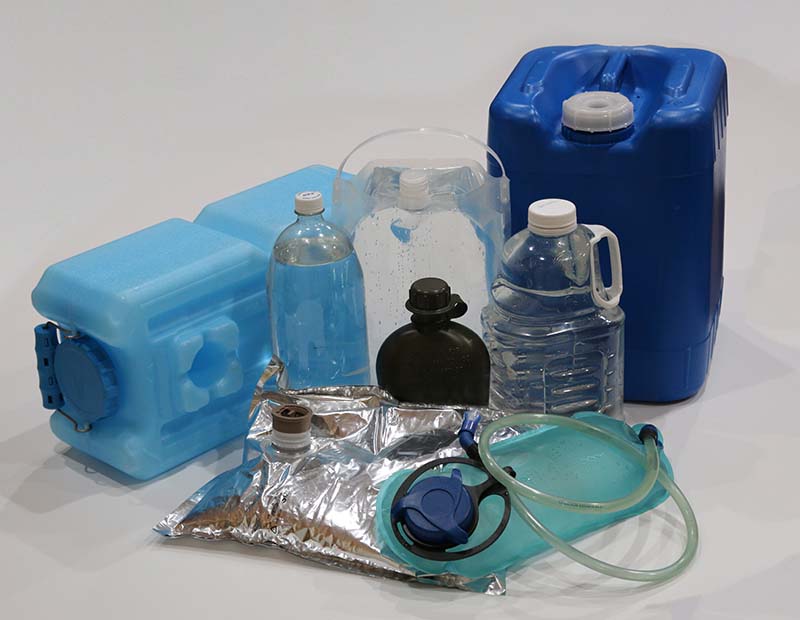Disaster Supply Kit: Water
THE POINT
DO THIS
- Determine what water treatment and water supplies works best for you and your family in your disaster supply kits.
- Put those in your emergency kits.
- Rotate as necessary.
Disaster Supply Kit: Water
 As stated before, it is recommended to have a minimum of one gallon of drinking water per person per day, but how do you store a three-plus day supply in your disaster supply kit? Each gallon of water weighs 8.34 pounds, so three gallons would be more than 25 pounds. That's a lot of weight and space. So how much should we carry in our kits?
As stated before, it is recommended to have a minimum of one gallon of drinking water per person per day, but how do you store a three-plus day supply in your disaster supply kit? Each gallon of water weighs 8.34 pounds, so three gallons would be more than 25 pounds. That's a lot of weight and space. So how much should we carry in our kits?
We recommend you carry about one full gallon of drinkable water in your disaster supply kit. Young children and the elderly may not be able to carry this much water but should still have as much as possible in their kits. Do the best you can according to your needs and abilities.
There are a few different options to carry water in a disaster supply kit. A simple solution is to include a number of commercially filled water bottles. They are easy to come by and relatively inexpensive. They have a recommended rotation of two to three years. A possible downside, they may not pack well in an emergency kit with limited space to begin with and tightly packing around them may cause them to burst in your kit, losing your water and destroying other items around them. If this is what you have to start with, go ahead and put them in your kit, but upgrade to a better container as soon as you are able. As all things in your disaster supply kit, check it every six months. Make sure it is not broken and is not leaking.

Water Pouches and Refillable Water Bag
A better option are commercially filled water pouches. Each pouch holds a little more than 4 fluid ounces of clean drinking water and has about a five year shelf-life. That's about 30 pouches for one gallon. That still seems like a lot, but the nice thing about pouches, they are easy to adjust how many you carry and still have an accurate count of how much water you have. Carry as much as you can comfortably carry and still leave room and weight in your disaster supply kit for other essentials. The only downside of water pouches, if you can call it that, is that they are one time use. Once you use the water, discard the empty pouch. they don't work very well for if you come across another source of water.
We recommend in addition to the water pouches that you add a refillable water container. You can use a hard water bottle or canteen, but because of their rigidity, they will always take a lot of room in your kit whether they have water in them or not. A nice thing with a metal canteen is you can boil your water directly in it for purification purposes. A collapsible plastic or Mylar water bag are great options for refillable water containers. They are light weight and take very little room when empty. If you come across a source of water, fill up the bag and if necessary, add water purification options directly into the bag. A personal preference is the hydration bladder style water bags with the attached drinking hose. It makes it easier to drink from the water bag while you are on the go, rather than stopping and digging in your kit for your water. Additionally, some water filters can be attached to the drinking hose making filtration and easy process. Be careful if the water bag is your primary water storage for your kit. You need to rotate the water every six months to a year, as opposed to the water pouches that have a five year shelf-life.

Water Purification Tablet
You also need some water treatment options in your disaster supply kit for the possibility of the additional water you find not being clean. One thing you can do is have a small cooking pot or the metal canteen mentioned earlier for boiling water. You'll also need a means of starting a fire. Water must boil for a full three minutes at Utah's average elevation to kill possible pathogens in the water. Water purification tablets are another option for killing pathogens. They are a good option for water purifying on-the-go, but they take considerably longer than boiling. Follow manufactures instructions and know that they have an expiration date. Ask your local emergency preparedness or outdoor retailer for recommendations. Purification tablets work best when used with a quality water filter. If you have additional room, include a small backpacking or personal filter. Larger ones have a hand pump that produce water quickly for small groups. This may be a good option if you have a family with small children. Other options include straw filters or filters that fit inline with a hydration bladder. Again, check with your local preparedness or outdoor retailor for suggestions.
12 Areas: Water
Click Here

Other Sources of Water
Click Here


